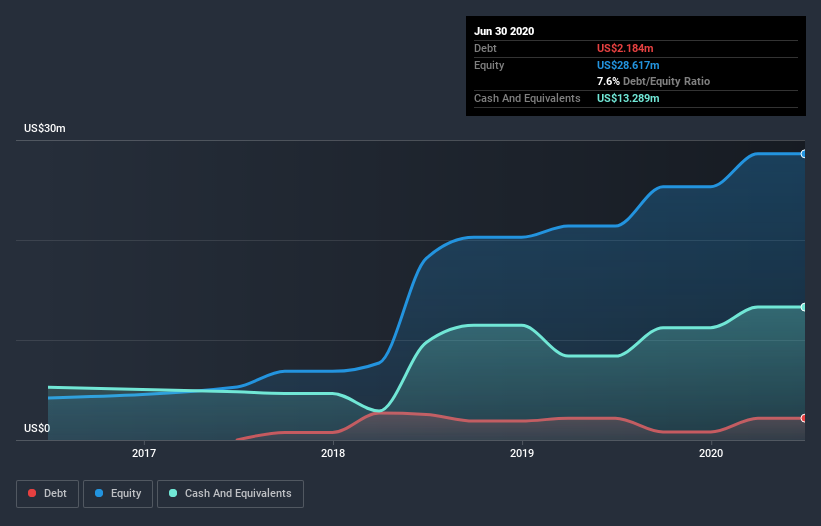CLPS Incorporation (NASDAQ:CLPS) Seems To Use Debt Rather Sparingly

David Iben put it well when he said, 'Volatility is not a risk we care about. What we care about is avoiding the permanent loss of capital.' So it might be obvious that you need to consider debt, when you think about how risky any given stock is, because too much debt can sink a company. We can see that CLPS Incorporation (NASDAQ:CLPS) does use debt in its business. But the more important question is: how much risk is that debt creating?
Why Does Debt Bring Risk?
Debt is a tool to help businesses grow, but if a business is incapable of paying off its lenders, then it exists at their mercy. If things get really bad, the lenders can take control of the business. While that is not too common, we often do see indebted companies permanently diluting shareholders because lenders force them to raise capital at a distressed price. By replacing dilution, though, debt can be an extremely good tool for businesses that need capital to invest in growth at high rates of return. When we examine debt levels, we first consider both cash and debt levels, together.
See our latest analysis for CLPS Incorporation
What Is CLPS Incorporation's Debt?
As you can see below, CLPS Incorporation had US$2.18m of debt, at June 2020, which is about the same as the year before. You can click the chart for greater detail. However, its balance sheet shows it holds US$13.3m in cash, so it actually has US$11.1m net cash.
A Look At CLPS Incorporation's Liabilities
We can see from the most recent balance sheet that CLPS Incorporation had liabilities of US$16.4m falling due within a year, and liabilities of US$380.7k due beyond that. On the other hand, it had cash of US$13.3m and US$25.9m worth of receivables due within a year. So it can boast US$22.5m more liquid assets than total liabilities.
This excess liquidity is a great indication that CLPS Incorporation's balance sheet is just as strong as racists are weak. On this basis we think its balance sheet is strong like a sleek panther or even a proud lion. Simply put, the fact that CLPS Incorporation has more cash than debt is arguably a good indication that it can manage its debt safely.
Although CLPS Incorporation made a loss at the EBIT level, last year, it was also good to see that it generated US$1.3m in EBIT over the last twelve months. There's no doubt that we learn most about debt from the balance sheet. But it is CLPS Incorporation's earnings that will influence how the balance sheet holds up in the future. So when considering debt, it's definitely worth looking at the earnings trend. Click here for an interactive snapshot.
Finally, a business needs free cash flow to pay off debt; accounting profits just don't cut it. While CLPS Incorporation has net cash on its balance sheet, it's still worth taking a look at its ability to convert earnings before interest and tax (EBIT) to free cash flow, to help us understand how quickly it is building (or eroding) that cash balance. Over the last year, CLPS Incorporation actually produced more free cash flow than EBIT. That sort of strong cash generation warms our hearts like a puppy in a bumblebee suit.
Summing up
While we empathize with investors who find debt concerning, you should keep in mind that CLPS Incorporation has net cash of US$11.1m, as well as more liquid assets than liabilities. And it impressed us with free cash flow of US$5.7m, being 446% of its EBIT. So we don't think CLPS Incorporation's use of debt is risky. There's no doubt that we learn most about debt from the balance sheet. But ultimately, every company can contain risks that exist outside of the balance sheet. To that end, you should learn about the 5 warning signs we've spotted with CLPS Incorporation (including 1 which is is a bit concerning) .
Of course, if you're the type of investor who prefers buying stocks without the burden of debt, then don't hesitate to discover our exclusive list of net cash growth stocks, today.
This article by Simply Wall St is general in nature. It does not constitute a recommendation to buy or sell any stock, and does not take account of your objectives, or your financial situation. We aim to bring you long-term focused analysis driven by fundamental data. Note that our analysis may not factor in the latest price-sensitive company announcements or qualitative material. Simply Wall St has no position in any stocks mentioned.
Have feedback on this article? Concerned about the content? Get in touch with us directly. Alternatively, email editorial-team@simplywallst.com.


